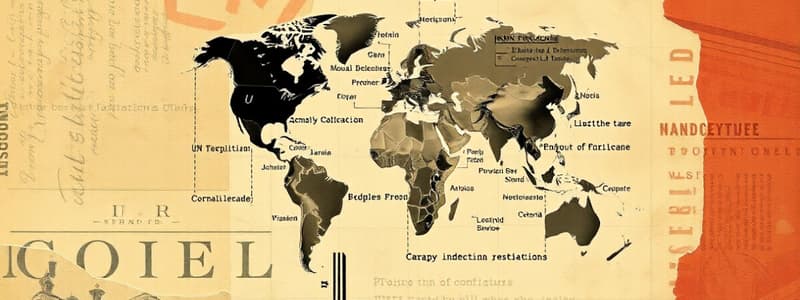Podcast
Questions and Answers
The United Nations was founded to promote equal rights and ______.
The United Nations was founded to promote equal rights and ______.
self-determination
As of 2019, there are 195 countries in the United Nations, including 193 members and 2 non-member ______.
As of 2019, there are 195 countries in the United Nations, including 193 members and 2 non-member ______.
observers
The Security Council has 5 permanent members with veto power, including China, Britain, USA, Russia, and ______.
The Security Council has 5 permanent members with veto power, including China, Britain, USA, Russia, and ______.
France
The General Assembly meets annually and also for ______ debates.
The General Assembly meets annually and also for ______ debates.
UNICEF is one of the important programs within the General Assembly, focusing on ______ health.
UNICEF is one of the important programs within the General Assembly, focusing on ______ health.
Flashcards
What is the United Nations?
What is the United Nations?
An international organization whose primary aim is to promote global peace, security, and development through cooperation between its member nations.
What is the General Assembly?
What is the General Assembly?
The main legislative body of the UN, where all member states have equal representation and voting power. It discusses and debates important issues, appoints the Secretary-General, and oversees various UN programs.
What is the Security Council?
What is the Security Council?
The UN's executive body responsible for maintaining international peace and security. It has 15 members, including 5 permanent members with veto power. It can authorize peacekeeping missions, impose sanctions, and authorize military action.
What is state sovereignty?
What is state sovereignty?
Signup and view all the flashcards
Who is the Secretary-General?
Who is the Secretary-General?
Signup and view all the flashcards
Study Notes
Principles of the UN
- To promote equal rights and self-determination
- To address international economic and social freedoms
- To promote human rights and fundamental freedoms
UN Structure - General Assembly
- 195 countries (193 members & 2 non-member observers - Palestine and Holy Vatican) as of 2019
- Meets annually and has emergency debates
- Each member has one vote
- Appoints the Secretary-General (currently António Guterres)
- Important programs include UNICEF, WFP, WHO, UNEP, and UNIFEM
UN Structure - Security Council
- 5 permanent members (China, Britain, USA, Russia, France) with veto power
- 10 non-permanent members elected to 2-year staggered terms
- Responsible for world peace; can order cease-fires, impose sanctions, and authorize the use of military action
- Programs include peacekeeping operations and international missions
Studying That Suits You
Use AI to generate personalized quizzes and flashcards to suit your learning preferences.
Related Documents
Description
This quiz covers the key principles and structures of the United Nations, including its focus on human rights, self-determination, and the roles of the General Assembly and Security Council. You'll explore the important programs and the voting system among member countries. Test your knowledge of how the UN operates and its significance in global affairs.




